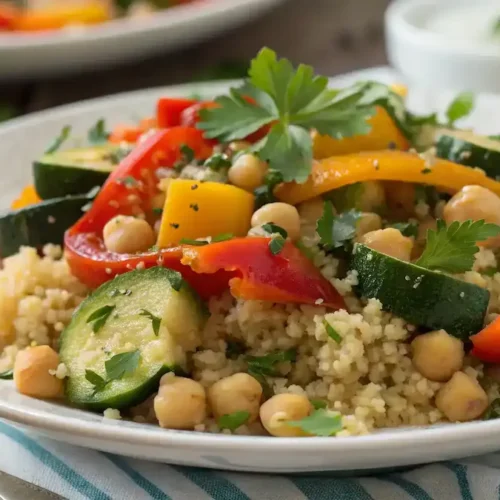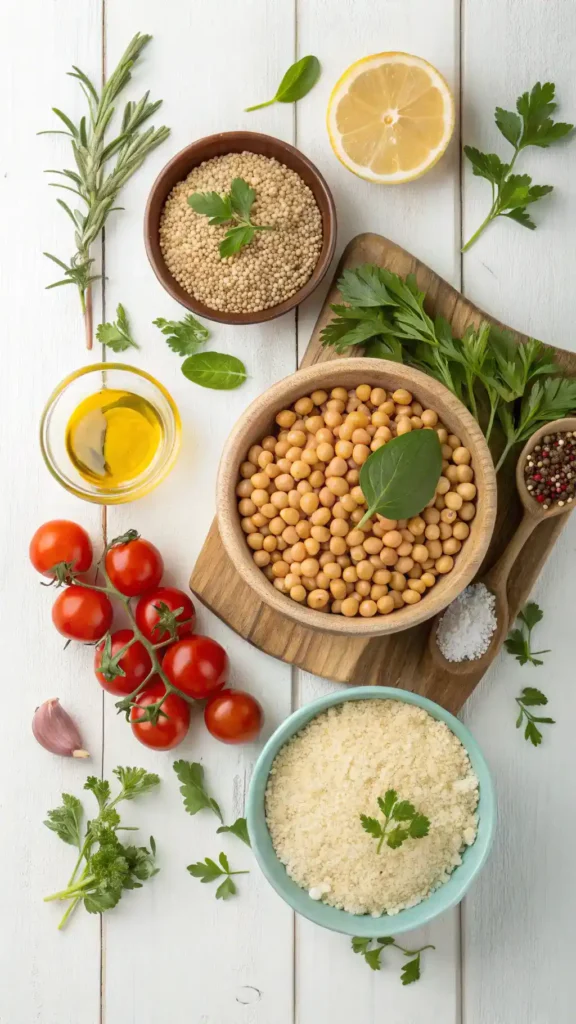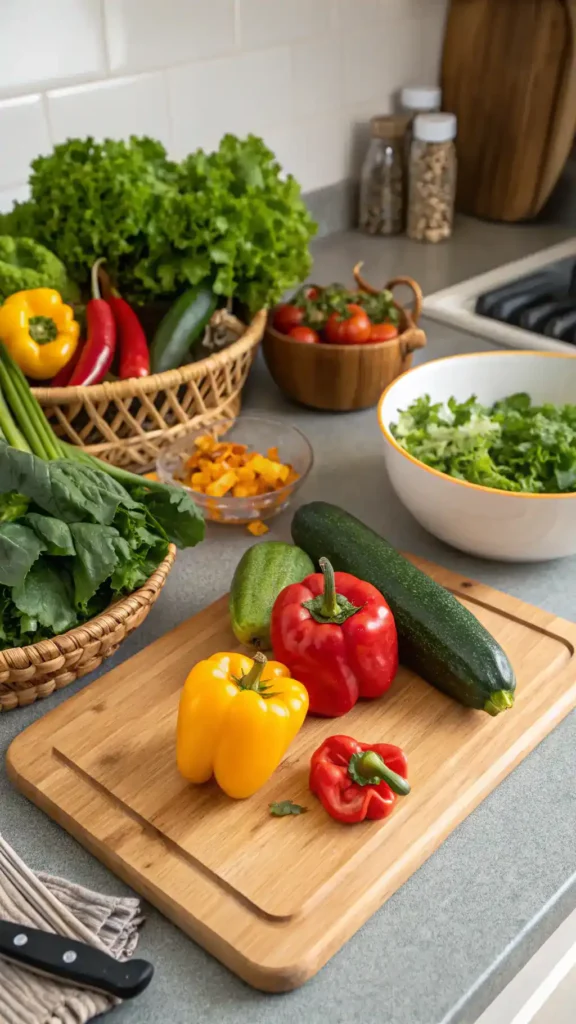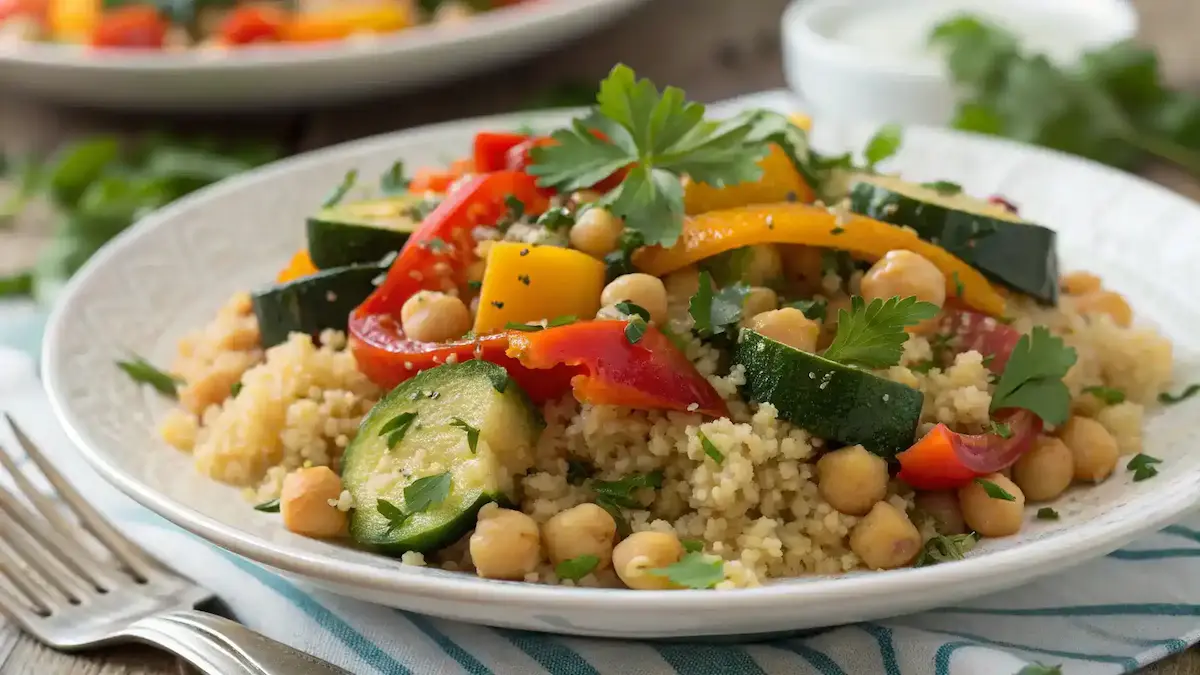Are you looking for delicious meals that are both nutritious and easy to prepare? If so, you’re in the right place! Gluten-Free Vegetarian Recipes not only cater to dietary restrictions but also offer a delightful array of flavors and textures. In fact, these recipes can be a game-changer for health-conscious individuals and busy families alike. Moreover, they provide an excellent way to incorporate more plant-based ingredients into your diet, ensuring you enjoy a nutrient-rich meal that supports weight management and boosts energy levels.
In this collection, you will discover how simple it is to create satisfying dishes using fresh vegetables, legumes, and gluten-free grains. For example, think of vibrant salads, hearty grain bowls, and flavorful stir-fries that can be whipped up in no time. Additionally, we’ll guide you through step-by-step instructions, making it easy for cooks of all skill levels to dive into the world of gluten-free vegetarian cooking.
So, whether you’re preparing a quick lunch or a family dinner, these recipes will inspire you to explore new culinary adventures. Let’s get started on this delicious journey together!
Table of Contents

Gluten-Free Vegetarian Recipes
Equipment
- 1 Cutting board For chopping vegetables.
- 1 Knife For cutting vegetables.
- 1 Pan For sautéing or cooking.
- 1 Baking sheet For roasting vegetables.
Ingredients
Fresh Vegetables
- 2 cups Bell Peppers Chopped.
- 1 cup Zucchini Chopped.
Legumes
- 1 can Chickpeas Rinsed and drained.
- 1 cup Lentils Cooked.
Gluten-Free Grains
- 1 cup Quinoa Cooked.
- 1 tablespoon Olive Oil For sautéing.
Herbs and Spices
- 1 teaspoon Cumin For flavor.
- 1 teaspoon Paprika For flavor.
- 1 teaspoon Turmeric For flavor.
Dairy Alternatives
- 2 tablespoons Nutritional Yeast For cheesy flavor.
Instructions
Gather Your Ingredients
- Start by collecting all your ingredients. For a basic gluten-free vegetarian recipe, you’ll need fresh vegetables, legumes like chickpeas or lentils, and gluten-free grains such as quinoa. This ensures a nutrient-rich dish.
Prep Your Vegetables
- Wash and chop your vegetables into bite-sized pieces. For instance, bell peppers, zucchini, and spinach work wonderfully together. Remember, uniform sizes help them cook evenly.
Choose Your Cooking Method
- Decide how you want to cook your dish. You can sauté, roast, or steam your ingredients. Sautéing in a bit of olive oil adds flavor, while roasting brings out natural sweetness.
Season Generously
- Don’t shy away from herbs and spices! Season your dish with salt, pepper, garlic, and perhaps a sprinkle of nutritional yeast for a cheesy flavor. This step is crucial for enhancing the taste of your gluten-free vegetarian recipes.
Cook to Perfection
- If you’re sautéing, cook over medium heat for about 5-7 minutes, stirring occasionally. For roasting, spread your veggies on a baking sheet and cook at 400°F (200°C) for 20-25 minutes. Keep an eye on them to avoid burning!
Combine Ingredients
- Once your vegetables are cooked, mix them with your chosen legumes and grains. This combination not only adds texture but also boosts protein content, making your meal more filling.
Taste and Adjust
- Before serving, taste your dish. If it needs more flavor, add a dash of lemon juice or a pinch of your favorite spice. This final touch can elevate your gluten-free vegetarian recipes to a whole new level!
Serve and Enjoy
- Plate your dish beautifully. Consider garnishing with fresh herbs or a drizzle of olive oil. Not only does this make it visually appealing, but it also adds a fresh burst of flavor.
Video
Key Benefits
When it comes to cooking, embracing Gluten-Free Vegetarian Recipes can be a delightful journey filled with health benefits and culinary creativity. Not only do these recipes cater to various dietary restrictions, but they also offer a wealth of advantages that can enhance your overall well-being. Here are some key benefits to consider:
- Nutrient-Rich Ingredients: Gluten-Free Vegetarian Recipes often incorporate a variety of fresh vegetables, legumes, and whole grains. This means you’re not just avoiding gluten; you’re also loading up on essential vitamins and minerals.
- Easy Digestion: Many people find that gluten-free diets improve their digestion. By choosing plant-based ingredients, you can enjoy meals that are easier on the stomach, which is especially beneficial for those with gluten sensitivities.
- Energy Boost: A plant-based diet can provide a steady source of energy. Foods rich in complex carbohydrates, like quinoa and brown rice, can keep you fueled throughout the day, making Gluten-Free Vegetarian Recipes perfect for busy professionals and active families.
- Weight Management: If you’re looking to maintain or lose weight, these recipes can be a great ally. They are typically lower in calories and high in fiber, which helps you feel full longer without the extra calories.
- Versatile and Flavorful: Contrary to popular belief, gluten-free vegetarian meals can be incredibly flavorful. With the right herbs and spices, you can create dishes that are not only healthy but also delicious.
In summary, incorporating Gluten-Free Vegetarian Recipes into your meal planning can lead to improved digestion, better energy levels, and a more balanced diet. So, why not give it a try? You might just discover a new favorite dish that nourishes both your body and soul!
Ingredients for Gluten-Free Vegetarian Recipes
Creating delicious gluten-free vegetarian recipes starts with selecting the right ingredients. Here’s a list of wholesome components that not only cater to dietary needs but also pack a flavorful punch:
- Fresh Vegetables: Think vibrant bell peppers, zucchini, and leafy greens. These not only add color but also provide essential nutrients. When choosing vegetables, opt for organic whenever possible for better flavor and health benefits.
- Legumes: Chickpeas, lentils, and black beans are fantastic sources of plant-based protein. They are versatile and can be used in salads, stews, or even as a base for veggie burgers. If you’re short on time, canned versions are a great alternative—just rinse them well!
- Whole Grains: Quinoa, brown rice, and gluten-free oats are excellent choices. They offer fiber and keep you feeling full longer. For a quick meal, consider pre-cooked grains available at many grocery stores.
- Gluten-Free Grains: Explore options like millet, buckwheat, and amaranth. These grains add unique textures and flavors to your dishes. Additionally, they are often overlooked but can be a delightful surprise!
- Herbs and Spices: Fresh herbs like basil, cilantro, and parsley can elevate your recipes. Spices such as cumin, paprika, and turmeric not only enhance flavor but also offer health benefits. Don’t hesitate to experiment with different combinations!
- Dairy Alternatives: Almond milk, coconut yogurt, and cashew cheese are great substitutes for traditional dairy. They provide creaminess without the gluten, making them perfect for sauces and dressings.
- Nutritional Yeast: This is a must-have for adding a cheesy flavor to your dishes without any dairy. It’s also packed with B vitamins, making it a nutritious addition.

When preparing gluten-free vegetarian recipes, remember that freshness is key. Always check expiration dates on packaged items and choose seasonal produce for the best taste. If you’re missing an ingredient, don’t worry! Many of these components can be substituted with similar items. For example, if you don’t have quinoa, brown rice works just as well. Overall, the goal is to enjoy the cooking process while creating meals that are both healthy and satisfying.
How to Make Gluten-Free Vegetarian Recipes
Creating delicious gluten-free vegetarian recipes is not only rewarding but also simple! Follow these easy steps to whip up a meal that’s both nutritious and satisfying. Let’s dive in!
- Gather Your Ingredients: Start by collecting all your ingredients. For a basic gluten-free vegetarian recipe, you’ll need fresh vegetables, legumes like chickpeas or lentils, and gluten-free grains such as quinoa. This ensures a nutrient-rich dish.
- Prep Your Vegetables: Wash and chop your vegetables into bite-sized pieces. For instance, bell peppers, zucchini, and spinach work wonderfully together. Remember, uniform sizes help them cook evenly.
- Choose Your Cooking Method: Decide how you want to cook your dish. You can sauté, roast, or steam your ingredients. Sautéing in a bit of olive oil adds flavor, while roasting brings out natural sweetness.
- Season Generously: Don’t shy away from herbs and spices! Season your dish with salt, pepper, garlic, and perhaps a sprinkle of nutritional yeast for a cheesy flavor. This step is crucial for enhancing the taste of your gluten-free vegetarian recipes.
- Cook to Perfection: If you’re sautéing, cook over medium heat for about 5-7 minutes, stirring occasionally. For roasting, spread your veggies on a baking sheet and cook at 400°F (200°C) for 20-25 minutes. Keep an eye on them to avoid burning!
- Combine Ingredients: Once your vegetables are cooked, mix them with your chosen legumes and grains. This combination not only adds texture but also boosts protein content, making your meal more filling.
- Taste and Adjust: Before serving, taste your dish. If it needs more flavor, add a dash of lemon juice or a pinch of your favorite spice. This final touch can elevate your gluten-free vegetarian recipes to a whole new level!
- Serve and Enjoy: Plate your dish beautifully. Consider garnishing with fresh herbs or a drizzle of olive oil. Not only does this make it visually appealing, but it also adds a fresh burst of flavor.

By following these steps, you’ll create a delightful gluten-free vegetarian recipe that’s sure to impress. Remember, cooking is all about experimenting, so feel free to adjust ingredients to suit your taste. Happy cooking!
Pro Tips, Variations, and Common Problems for Gluten-Free Vegetarian Recipes
Cooking gluten-free vegetarian recipes can be a delightful adventure, but it does come with its own set of challenges. Here are some pro tips to help you navigate the kitchen with confidence and creativity!
Pro Tips
– Experiment with Gluten-Free Flours: When baking or thickening sauces, consider using almond flour, coconut flour, or a gluten-free all-purpose blend. Each brings a unique flavor and texture to your dish.
– Add Flavor with Herbs and Spices: Since gluten-free vegetarian recipes can sometimes lack depth, don’t hesitate to enhance flavors with fresh herbs like basil, cilantro, or spices such as cumin and smoked paprika.
– Incorporate Plant-Based Proteins: For a satisfying meal, include legumes like chickpeas or lentils. They not only boost protein content but also add heartiness to your dishes.
Creative Variations
– Swap Out Ingredients: If you’re out of a specific vegetable, feel free to substitute with whatever you have on hand. For instance, zucchini can replace eggplant, and quinoa can stand in for rice.
– Try Different Cooking Methods: Instead of sautéing, consider roasting or steaming your vegetables. This can enhance their natural sweetness and add a delightful texture to your gluten-free vegetarian recipes.
– Make It a Meal Prep: Prepare larger batches of your favorite dishes and store them in airtight containers. This way, you’ll have quick, healthy meals ready to go throughout the week.
Common Problems and Solutions
– Texture Issues: If your dish turns out too mushy, it may be due to overcooking. Always check for doneness a few minutes before the suggested cooking time. Conversely, if it’s too dry, add a splash of vegetable broth or olive oil to moisten it up.
– Seasoning Problems: If your dish tastes bland, remember that gluten-free vegetarian recipes often need a bit more seasoning. Start with salt and pepper, then add a splash of lemon juice or a dash of soy sauce for an umami kick.
– Binding Challenges: When making veggie burgers or fritters, if they fall apart, try adding a binding agent like ground flaxseed mixed with water or gluten-free breadcrumbs. This will help hold everything together beautifully.
By keeping these tips in mind, you’ll be well on your way to mastering gluten-free vegetarian recipes. Enjoy the process, and don’t hesitate to get creative in the kitchen!
Serving Suggestions for Gluten-Free Vegetarian Recipes
When it comes to serving gluten-free vegetarian recipes, presentation is key! Not only does a beautifully plated dish entice the eyes, but it also enhances the overall dining experience. Here are some delightful serving ideas to elevate your meals:
Plating Ideas
Consider using vibrant plates that contrast with the colors of your dish. For instance, a deep blue plate can make a colorful quinoa salad pop. Additionally, you can layer ingredients for a more dynamic presentation. For example, stack roasted vegetables atop a creamy hummus base, and drizzle with a balsamic reduction for that extra flair.
Side Dish Pairings
Pair your main dish with complementary sides to create a well-rounded meal. For instance, serve a hearty lentil stew alongside a fresh arugula salad topped with cherry tomatoes and a zesty lemon vinaigrette. Alternatively, consider a side of gluten-free garlic bread or a warm quinoa pilaf to round out the flavors.
Garnishing Tips
Garnishes can transform a simple dish into a culinary masterpiece. Fresh herbs like basil, cilantro, or parsley not only add color but also enhance flavor. For example, sprinkle chopped chives over a creamy potato dish or add a handful of microgreens atop a vegetable stir-fry. Moreover, a squeeze of fresh lemon or lime can brighten up any plate.
Creative Serving Options
Depending on the occasion, you can choose different serving styles. For a casual family dinner, consider a family-style setup where everyone can help themselves. Place your gluten-free vegetarian recipes in large bowls at the center of the table. On the other hand, for an elegant gathering, serve individual portions on stylish plates, perhaps with a small side of artisan bread or a delicate salad.
Furthermore, don’t forget about the power of color! Incorporating a variety of colorful vegetables not only makes the dish visually appealing but also ensures a nutrient-rich meal. For instance, a rainbow vegetable stir-fry can be both a feast for the eyes and a healthy choice.
In summary, serving gluten-free vegetarian recipes can be both fun and creative. By focusing on plating, pairing, garnishing, and presentation styles, you can impress your guests while ensuring a delightful dining experience. So, gather your ingredients and let your culinary creativity shine!
Preserving and Reheating Gluten-Free Vegetarian Recipes
Storing and reheating your Gluten-Free Vegetarian Recipes properly is essential for maintaining their delicious flavors and delightful textures. Let’s dive into some practical tips that will help you enjoy your meals even days after cooking!
Storage Tips
To keep your Gluten-Free Vegetarian Recipes fresh, always store them in airtight containers. This prevents moisture and air from spoiling your food. If you plan to eat leftovers within a few days, refrigeration is perfect. Generally, they stay fresh in the fridge for about 3 to 5 days. However, if you want to keep them longer, consider freezing. Most dishes can last up to 3 months in the freezer when stored properly. For optimal freshness, vacuum-sealing is an excellent option, as it removes air and helps prevent freezer burn.
Additionally, always label your containers with the date you cooked the meal. This way, you can easily track how long they’ve been stored. Food safety is crucial, so remember to cool your dishes to room temperature before refrigerating or freezing. This practice helps prevent bacterial growth, ensuring your meals remain safe to eat.
Reheating Methods
When it comes to reheating your Gluten-Free Vegetarian Recipes, you have several options. The oven is a fantastic choice for maintaining texture. Preheat it to 350°F (175°C), place your dish in an oven-safe container, and cover it with foil to retain moisture. Heat for about 15-20 minutes, checking occasionally to ensure it doesn’t dry out.
If you prefer the stovetop, this method works well for soups and stir-fries. Simply add a splash of vegetable broth or water to your pan, then heat over medium heat, stirring frequently until warmed through. This technique not only warms your food but also refreshes its flavors.
For a quick option, the microwave is convenient. Place your dish in a microwave-safe container, cover it with a damp paper towel, and heat in short intervals of 1-2 minutes, stirring in between. This method helps keep your food moist and prevents overcooking.
Lastly, if you have an air fryer, it’s a great way to reheat dishes like veggie patties or roasted vegetables. Set it to 350°F (175°C) and heat for about 5-7 minutes. This method crisps up the exterior while keeping the inside tender.
In summary, with these storage and reheating tips, you can enjoy your Gluten-Free Vegetarian Recipes at their best, even days later. So, go ahead and savor those leftovers without worry!
Conclusion
As we wrap up this delightful journey into the world of Gluten-Free Vegetarian Recipes, let’s take a moment to recap the key steps. You’ve learned how to combine fresh vegetables, legumes, and gluten-free grains into a nourishing dish that is not only simple but also incredibly versatile. Whether you sauté, roast, or steam, the techniques are straightforward, making it easy for anyone to create a delicious meal. So, why not give it a try? You might just discover a new favorite!
Share Your Experience
We would love to hear about your culinary adventures! Feel free to share your results or ask any questions you may have. Additionally, don’t hesitate to experiment with variations or pairings that suit your taste. Cooking is all about creativity, and these Gluten-Free Vegetarian Recipes are a fantastic way to express yourself in the kitchen.
Remember, cooking should be fun and fulfilling. Embrace the process, and enjoy the journey of creating healthy, delicious meals that cater to your dietary needs. Happy cooking!
FAQ
What are some easy gluten-free vegetarian recipes?
There are plenty of easy gluten-free vegetarian recipes to try! For example, you can make a quinoa salad with fresh vegetables, a hearty lentil soup, or roasted vegetable tacos. Additionally, stir-fried tofu with broccoli and gluten-free soy sauce is a quick option. These dishes are not only simple but also packed with nutrients!
How can I ensure my gluten-free vegetarian recipes are flavorful?
To enhance the flavor of your gluten-free vegetarian recipes, use a variety of herbs and spices. For instance, garlic, cumin, and paprika can add depth to your dishes. Moreover, don’t forget to season with salt and pepper to taste. Experimenting with different flavor combinations can make your meals exciting and delicious!
What are some common substitutions for gluten in vegetarian recipes?
When cooking gluten-free vegetarian recipes, you can substitute gluten-containing ingredients with alternatives. For example, use gluten-free flour blends for baking or gluten-free pasta for your favorite noodle dishes. Additionally, quinoa and rice are excellent substitutes for grains. Always check labels to ensure products are certified gluten-free!
Can I meal prep gluten-free vegetarian recipes?
Absolutely! Meal prepping gluten-free vegetarian recipes is a fantastic way to save time during the week. You can prepare dishes like veggie stir-fries or grain bowls in advance. Just store them in airtight containers in the refrigerator. This way, you’ll have healthy meals ready to go whenever you need them!
How do I store leftovers from gluten-free vegetarian recipes?
To store leftovers from your gluten-free vegetarian recipes, place them in airtight containers. This helps maintain freshness and prevents spoilage. Generally, most dishes can be stored in the refrigerator for up to three days. If you want to keep them longer, consider freezing them. Just remember to label your containers with the date!

